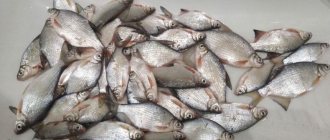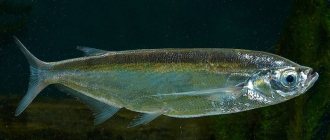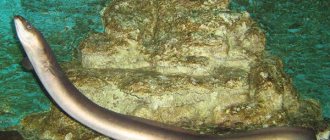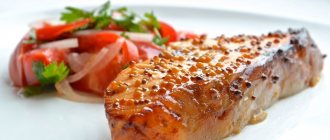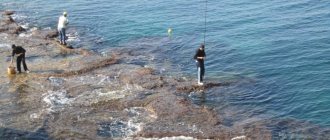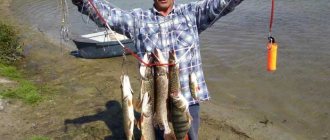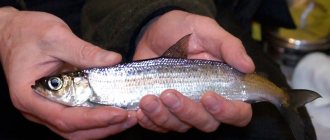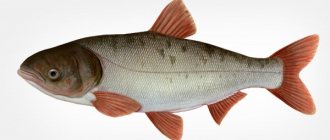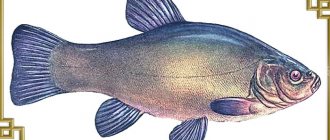General information
Podust
Latin name:
Chondrostoma nasus
Other names:
Blackbelly
Family:
Cyprinidae
Genus:
Podusts
Type:
freshwater
Lifestyle:
benthic
Diet type:
peaceful
Podust is part of the carp family. There are 18 varieties of it in freshwater bodies of Asia and Europe. Previously, this fish was common in Russia. It is very sensitive to water pollution. Nowadays it has become very rare, only in clean reservoirs with water saturated with oxygen. The lifespan of podust in clean water can reach up to 10 years. Popularity belongs to the common podust. Fishermen also call it blackbelly.
Description of the species
The standard size of representatives of the genus Chondrostoma is 25-30 cm with a weight of 400-500 g. Trophy specimens reach 1.2-1.5 kg (40-45 cm). The largest podust weighs 1.8-2.0 kg with a height of over 50 cm. But such individuals are extremely rare, since they reach their maximum dimensions at the end of life, which is 10-12 years.
The fish got its name from the lower terminal mouth (old mouth), located under the elongated cartilaginous snout, like a sturgeon. Another common nickname is the black belly, due to the special dark film on the inner walls of the abdominal cavity.
The main distinctive characteristics of the appearance of the undermouth include:
- body flattened laterally in the shape of a pointed ellipse;
- yellowish-orange pectoral, pelvic and anal fins;
- medium, tightly fitting silvery scales with a rounded posterior edge (cycloid type);
- dark olive color of the back, on which a smoky-gray fin is located (3 unbranched and up to 10 branched rays);
- low head with a flat nose and large eyes;
- clearly visible lateral line of dark color;
- black rim on the tail.
The color pattern and tone depend on the genus taxon, specific habitat conditions in the river and the season: during the spawning period, all orange, yellow and red shades on the fins of males become an order of magnitude brighter.
Volzhsky Podust
Latin name: Chondrostoma variabile. Listed in the Red Book of the Saratov Region as a “vulnerable species.” It is distinguished by its more modest size (up to 1.4 kg) and shorter life expectancy (up to 8-9 years). The lower jaw has a sharp end. There are 52-62 scales in the lateral line. The dorsal fins are greenish in color. It lives in tributaries and rivers of the European part of Russia (Volga, Don, Ural), also found in the Sura, Moscow River, Oka and large reservoirs (Kuibyshev, Volgograd, Saratov).
To learn more:
Common loach and Amur loach: lifestyle, spawning and fishing
Genoese (Western European) podust
The name in Latin is Chondrostoma genei. It lives in Italy, Slovenia, Austria, Belgium, France, Switzerland and in many rivers of the Adriatic and North Seas. The fish is distinguished by its yellow-green back and colorless fins. The lateral line runs through the entire strongly elongated body, but is poorly visible. Grows up to 35-40 cm (1.2-1.4 kg).
Dneprovsky Podust
The Latin name of the fish is Chondrostoma nasus nasus natio borysthenicum Berg. It has a moderately high body and a light, scaleless keel between the anal and ventral fins, colored red. Habitats are rivers, tributaries and reservoirs that form the basin of the Black and Azov Seas. Podust is especially numerous in the Dnieper and Southern Bug. Grows up to 1.5 kg (up to 45 cm).
Appearance
The structure of the body suggests that the fish is a representative of a freshwater habitat and spends a long time at the bottom or in the bottom layers of a reservoir or river. The body of the podust is oblong, slightly cobbled, the sides and back are not flattened. The head is small, rounded with an elongated upper lip or nose, and the lower lip is cartilaginous. The eyes are small and located on the sides. The color is light and shiny. Only the back has a slightly dark color - it is greenish-black. The sides and belly are silvery and have a bright tint. The entire body is covered with scales. The dorsal fin is dark in color – almost black. The caudal fin is gray or with a reddish tint and a black border. The remaining fins, which are located on the lower part of the body of the podust, are reddish. Many individuals have slightly noticeable dark spots on the sides, which disappear by the spawning period.
Fishing for undermouth in the fall
In autumn, podust is caught in deeper areas than in summer. In this case, it is better to use a match or Bolognese fishing rod, adapted for long casts. Donks and feeders work, but worse because of the weight and feeder, noisily falling into the water.
In autumn, the dust concentrates in local zones with a depth of 2.5 to 4.5 meters. Areas behind the rifts, near holes and in the lower part of the edges, as well as behind the coastal dump are considered promising.
Podust are often caught in the same places as ide. Moreover, the emphasis is on fishing from the bottom. There he still finds the remains of plant food, and subsequently switches to plant food. For this feature, the under-dust is also called a “scraper”. It scrapes vegetation and other food from the bottom with its mouth.
At the beginning of autumn, podust is still caught using bottom rigs, and then a float rod is used. Fishing is carried out by wire. It has been established that the colder the water, the slower the wiring should be. Since the bait takes the bait decisively, you can use heavier floats that will slow down the movement of the equipment. It is effective to make small holds during postings. The nozzle either drags along the bottom or is 5 cm higher.
The most effective baits for fishing underwater in the fall are granny - a mayfly larva and amphipod, which can be found under stones, near dams and bridge supports. Place one or two pieces on the hook. It has been noticed that larger specimens are caught on amphipods and grandmas. Walnut worms are also a success among podusts. They live in hazelnuts that have fallen to the ground. The length of such a worm is 5-7 mm. Its body is yellow with a black head.
They are caught using maggots, bloodworms and pieces of worms. But smaller specimens bite on these baits.
In autumn, podust is caught using the thinnest gear. Hooks use Nos. 16-20 according to international numbering, fishing line with a cross-section of 0.14-0.18 mm. When fishing with a feeder, it is better to feed immediately and then use small feeders. When fishing at long distances, the priority is a fence with a cross section of 0.1 mm. At a distance, bites will be visible very clearly on braided line.
Autumn fishing page
There is information about fishing for all river fish in the fall.
Lifestyle
This fish forms numerous schools consisting of tens or even hundreds of individuals of approximately the same size. Podust is unpretentious and very trusting, which makes it an easy prey for fishermen. The fish are very attracted to the turbidity; you can often watch them swim almost to the very feet of bathing people. They look for insect larvae in the silt and sand raised from the bottom. Fish often come to the surface (melt) in May–June, when a massive emergence of bloodworms occurs. Due to the special location of the mouth, the pod is forced to turn over when grasping food from the surface of the water, showing a light belly. This makes it easy to distinguish the swim of this fish from others.
The common podust is a fish that leads a diurnal lifestyle. In sunny weather, you can clearly see long rows of schools standing at the bottom. They are sometimes very numerous. At night, the fish goes deeper or closer to the shore, hiding in the bushes, where they often fall into fishing nets and baskets.
Podust is very sensitive to water spoilage. But when there is a toxic release from riverine factories, it does not leave the riffle, as, for example, gudgeons do, but hides behind stones. As a result, almost every summer you can see large numbers of half-dead podust floating along the river, carried away by crows and kites.
The common podust, being a diurnal fish, feeds mainly on filamentous algae and detritus. He collects them from stones, snags, piles, skillfully scraping them with his lips. Podust causes great harm to other fish in the spring, eating their fertilized eggs and scraping them from underwater objects. Part of the diet during this period also consists of dung and earthworms. But with the beginning of summer, the common podust becomes a herbivorous fish - its diet consists entirely of river vegetation.
Features of character and lifestyle
Photo: Podust in Belarus
Podusts prefer fast-moving plains in rivers and search for food in schools, in open areas, where they hunt small animals and eat algae on the ground. From March to May they appear in schools on flat and heavily crowded gravel areas. They often make extended spawning trips as so-called “mid-level tourists.” They need warmer, quieter areas for larval development and deep, quiet areas for sleep.
The species is relatively sessile, benthic and gregarious. Podust forms schools of varying sizes and ages, often associated with other rheophilic carp fungi. During the spawning season, they can migrate even several hundred kilometers to reach areas suitable for laying, often located in small tributaries where adults do not stop for the trophic phase.
From early spring to late autumn, schools are very active and move along the bottom of streams in search of food. During this period, they often congregate near obstacles that slow the water's speed, such as bridge abutments, large boulders, submerged tree roots, or submerged trunks. In winter they move into deep waters, hiding in crevices or under large boulders, protected from strong currents, where they remain latent or have reduced activity.
Spreading
The place of distribution of podust are fresh rivers that belong to the basin of the Baltic, Black, Azov, Caspian, and Aegean seas. This fish is found in almost all rivers of Europe and the European part of the Russian Federation. There is podust in France, Germany, Switzerland. Australia, Italy and other European countries. Among the rivers where Podust occupies one of the leading positions in terms of numbers are: Volga, Oka, Terek, Ural, Kuban, Don, Bug, Kama, Dniester, Vistula, Dnieper, Danube, Kura and others. According to their habitat, ordinary or European podust, Volga, Kuban, Terek, Ural and other subspecies of podust are distinguished. The name, as you might guess, comes from the river in which this or that subspecies lives.
Description of the fish
The description of the podust is as follows. It belongs to the carp family and has very similar anthropometric data.
The average length of the fish is about 10-14 centimeters, and the weight is 200-350 grams. Adult males and females during 3 years of intensive development can reach a length of 25-30 centimeters and 1-1.5 kilograms of live weight.
The fish gets its name from its lower jaw. The distinctive features of the podust from all other fish include:- Flattened side.
- Slightly silvery and dense scales.
- Excellent sense of smell.
- Small head.
- A rounded black rim located on the tail.
- The gills are red.
Read here Sea crucian carp: 75 photos of fish, main varieties, fishing methods and choice of gear
Nutrition
Podust fish
Podust is predominantly a herbivorous fish. Its main food is algae and other plants that the podust finds in the bottom areas of the reservoir. In addition to plant foods, the podust feeds on insect larvae, the insects themselves, small invertebrates, worms, and the eggs of other fish. They begin feeding in the early morning and continue throughout the day. At dusk they go into hiding. However, it does not stop feeding at night, although it is a diurnal fish and is most active during the daytime. Podust is a very active fish, fast and agile, which continues to be active in hot and cold weather. In summer, even in extreme heat, when other fish stop feeding for a while and go into the shade or other shelters, the podust continues to feed and lead an active life. The same can be said about the winter season. Podust does not hibernate or become torpor, it continues to be active and look for food, so you can catch this fish in winter, the main thing is to know the parking places, which is sometimes not easy, given that the rivers are covered with thick layers of ice.
Spawning and fishing spots
In April-May, spawning begins near the underdust. The female lays eggs only at night in rivers with moderate currents. A week later, larvae emerge from the eggs. This fish cannot be found in rivers where the water smells like mud and blooms in the last month of summer.
If there is podust in the river, then it can be detected very easily. You need to take a closer look at the snags, bottom depressions, and sand pools. You can see a small school of these beautiful and large fish. Places with strong currents and rapids should be excluded from the search for underwater. Fish don't go into them. It cannot be found in rivers with no current or prone to blooming. The fish avoids the muddy green water. Podust can be found near underwater snags and stones washed by the current. It can also be seen on large pebble bottoms by its red ventral fins. Clay steep banks are also interesting for him. The fish come there for worms, larvae and other invertebrates, which are washed away by the current. He can spend the whole day in such places and moves little.
In the evening it will move shallow. It becomes not very dangerous there, there is food. And algae that have a filamentous appearance allow more light to pass through. You need to fish in the morning or evening dawn. At this time she swims along the shore. You can start fishing at the end of May or June. This will depend on the rate at which the water bodies warm up. Podust fishing ends with the onset of cold weather. At this time, the undergrowth rolls into wintering pits and hardly feeds. In winter, it is almost impossible to fish for podust.
How to detect podust on a pond
Podusta, unlike other fish, can be tracked in a body of water, as it leaves traces of its presence. While feeding, they leave traces of eaten algae on stones and other objects. They are usually crescent-shaped, ranging from 10 to 30 mm wide. When feeding, they sometimes turn to the side to reach food in inconvenient places, at which point their silvery body reflects light and they are easy to see in the pond.
Their habitats are rivers with a strong current and a rocky bottom, but not with a rapid flow, as this prevents the growth of algae. Algae should grow on the rocks that lie at the bottom. Where the stones are clean, there will most likely be no dust.
Podust does not like very cold water, so there is no point in catching it at depths of more than two meters.
We recommend: Common bleak, description, lifestyle, interesting facts
During the day they usually stay closer to the middle of the river and in deep places. In the evening they move to shallow water, but at this time they are very careful and are easily frightened. Closer to dawn they go deeper again.
The best time for fishing is the second half of the day.
Nozzles, lures, groundbait
Podust is almost always hungry. His food is low calorie. Therefore he is omnivorous. He will greedily grab meat delicacies: maggots, dung worms, bloodworms, tubifex. Biting on larvae and water-dwelling insects will be successful. You can offer him a dragonfly. He knows her very well, because she spends part of her life under water. On hot days it can be caught using plant baits. You can use dough or potato balls. Loves podust and pea puree. It can be caught with an unpainted lead jig (pellet, uralka or drop). Can't be caught with lures.
There is no need to attach the fish to one place. The fisherman must know where the fish accumulate. And bait is definitely needed. This will keep the school in the fishing area. Lumps of dense clay with a worm mixed in it, small maggots, bloodworms or tubifex are suitable. In winter, you should not skimp on complementary foods. He loves not only protein foods, but also plant foods. Fish like steamed buckwheat porridge. Podust will be happy to approach the hole.
Baits and lures
The black belly has an excellent appetite; it readily eats animal and plant foods. The following can be used as a catch bait for the undermouth:
- dough, bread crumb, boiled peas;
- steamed grains, pearl barley, snail meat;
- mastyrka, bloodworms, maggots;
- earthworm and dungworm;
- honeydew, bark beetle larva, bunch of filamentous algae;
- caddisfly, a piece of crawling, large ant eggs.
It is not recommended to use hooks with a long shank for fishing, since then the fish cannot completely swallow the bait. At the moment of hooking, the sting of the hook simply slides off the hard lips of the undermouth or pierces only their edge, which is not enough for successful fishing.
To learn more:
Varieties of perch: description, habitats and habits
Fishing methods
Fishing for undermouth
When choosing a fishing method, you must take into account that undermouth can provide resistance. It will rush with the current and will be able to break the thin fishing line. For fishing it is recommended to use:
- float rod. This tackle is very convenient and effective. In winter, you can also catch fish with a nodding rod.
- float rod for line fishing. Usually they fish from a boat or shore. Using this tackle, you can place the bait where it is impossible to hold it with other tackle. The leash should have a cross-section two times smaller than that of the main line. When hooked, this is to save the tackle.
- in English. The method involves long-distance casting of the float. The leash should have a diameter of up to 0.1 mm. Small pellets can serve as loading. As they approach the hook, their weight should decrease.
Podust fishing is a very exciting activity. The fish does not immediately swallow the bait, but keeps it in its mouth for some time. This helps the pod to easily release from the hook. But even if the podust is hooked, don’t rush to consider it luck. He will resist quite strongly, making intricate jerks. But these movements will not last long.
Podust is most successfully caught from the end of May to the beginning of July from 9 a.m. to 7 p.m., using a float rod, wiring, a match rod (in English) or bottom tackle. In winter, use a regular winter fishing rod with a float or a nod to a jig. The gear must be durable. You need to fish 5-10 cm from the bottom, since the podust does not take bait above its mouth.
The bait can be steamed cereal (wheat, rye, oats), pieces of worms, maggots, bloodworms, dragonfly larva, a bunch of tubifex worms and other insect larvae, as well as green filamentous algae rolled into balls. In hot weather, you can fish with baits made from dough, peas and potatoes with flavors. Groundbait significantly improves the bite. It can be various porridges, breadcrumbs, cake, chopped worms and insect larvae mixed with clay or soil.
It is curious that the podust does not pay attention to the process of catching it, so the entire flock can become a fisherman’s catch. The bite from the pod is sharp and confident; it pulls the float to the side and hooks itself. When playing, he resists strongly, but gets tired quickly.
How and what to catch podust
Almost all methods of fishing for bottom fish in the current are suitable, but fishing with a float rod using the retrieving method is considered the most interesting and effective.
Despite its modest size, the podust is distinguished by great strength and endurance, so the equipment should be light, but withstand powerful jerks.
The optimal gear parameters look like this:
- a rod with a fast action, 3.0-3.5 meters long;
- inertial coil;
- main line – 0.22-0.25 mm (with breaking load from 3 kg);
- leashes – 0.16-0.2 mm;
- hooks with a short shank No. 10-5 (international numbering) or No. 5-8 (standardization of the Russian Federation).
To learn more:
What is included in Minenko boilies?
Due to constant feeding at shallow depths, the blackbelly is quite bold and comes close to fishermen's boats. But noises from the shore alarm him; here it is better to use long-range gear.
Fishing on a feeder
Rods with a length of 3.5-3.9 m with a medium-fast action and a cast of up to 120 g are used. For long casts from 40-45 m, a braided cord of 0.12-0.15 mm is wound on a spinning reel with a spool capacity of 3000-4000. For fishing at a distance of up to 40 meters, you can use 0.22-0.25 mm monofilament.
For fishing undermouth in the spring and from September to October, it is wise to use an asymmetrical loop. It provides better visualization of the bite and free movement of the feeder at a distance of 30-60 cm, which allows cautious fish to swallow the bait deeper without any resistance from the gear. Fishing for subdust in June, July and August does not require complex equipment; either a symmetrical loop or any other feeder installation will do. In addition, you can use classic donks without a feeder.
Spinning fishing
Despite its herbivorous nature, podust responds well to artificial moving baits, especially in the fall. Small spoons, spinners, wobblers and silicone baits designed for catching chub, ide, asp are suitable - Blue Fox Super Vibrax, Forest Crystal, Strike Pro, BJ-Bug. In this case, the spinning retrieve must be slow enough so that the fish has time to grab it with its low mouth.
Economic importance
Podust has no commercial significance. The reason is that recently it is hardly found in large quantities. In addition, its bottom-dwelling lifestyle and habitats make it difficult to catch. Most often, podust becomes prey for an amateur fisherman armed with a simple fishing rod. It does not particularly readily go into muzzles and other similar devices. But it is also difficult to catch with a fishing rod. There are few such specialists among fishermen who catch podust in poods. The bite of this fish requires a quick hook, and it is quite strong and often breaks off. In addition, it requires good feeding in large quantities.
Podusta meat is tasty, dietary, and has various beneficial properties. It must be prepared immediately after catching fish, as it tends to spoil very quickly.
Podust common - freshwater fish
Podust belongs to the carp family. Eighteen varieties of this fish can be found in fresh water bodies of Europe and Asia.
The most popular is the common podust (Chondrostoma nasus). The length of its body can reach 50 cm with a total weight of 1.5 kg.
This subspecies is found in the rivers of central Europe, as well as in the basins of the Black and Caspian Seas. Ch. Nasus is a classic schooling fish that lives in the lower layers of fresh water. Aquatic vegetation acts as the main food for the common podust. Puberty occurs at the age of 3-4 years. A female podusta is capable of laying up to 12 thousand eggs at a time. The mating season begins in late spring. To do this, adults choose places with fast currents and a rocky bottom. To procreate, the males of the Podust change their color, they become brighter and more attractive.
Common Podust (Chondrostoma nasus).
This fish got its name in Russia due to its special appearance. The mouth located under the strongly protruding conical nose determined the future name. Podust has an external resemblance to fish or raw material.
The main differences between the fish and the fish are its slab-shaped body, straight mouth, small eyes and short anal fin. The teeth under the mouth also have a different shape. The fish has a dirty green color. The lateral and abdominal parts of the body are lighter than the back and have a shiny silvery tint. The fins of the podust are colored in shades of red, and only the dorsal fin is black.
Podusta in our country is called black belly.
Like many other fish, male podustas become much more attractive during the mating season. And the corners of the mouth, the ends of the gill plates and the base of the fins of the chest acquire white or orange spots. From the head to the very tail, a dark stripe appears on the body and even dark dots appear on the scales. Another variety of podust, Moskvoretsky, does not have this feature and practically does not change in any way during spawning. Studying the internal structure of fish of this family, it became known that the male has a black ventral hymen, which reaches its maximum saturation precisely during the spawning period. Because of this, podust has other names: black-bellied or black-bellied.
Chondrostoma is a small fish. The maximum size of an adult rarely reaches 44 cm, with a weight of no more than 1.2 kg. It is very rare in nature to find podust weighing more than 1.3-1.5 kg. The average individual weighs 400-500 g with a body length of up to 30 cm. This species of fish inhabits almost all European rivers. The only exception is the cold waters of the northern rivers of Europe.
On the territory of Russia, Podust inhabits reservoirs up to the Western Dvina. According to ichthyologists, it got there from the Berezina River through the Lepel Canal and large tributaries of the Volga. In the north and north-west of Russia, this fish is extremely rare.
Podust lives in fresh waters.
The population of podust in large rivers of the Black Sea and Caspian basins is much smaller than in some reservoirs in Germany and Switzerland. Another variety is Ch. Variabilis, considered a subspecies of the Volga podust, is found in the waters of the Don, Volga and Ural. The basins of the Dniester, Dnieper and Bug are inhabited by the Dnieper podust (Chondrostoma nasus nasus natio borysthenicus Berg), which practically does not reach the mouths of these rivers and is therefore not so widespread.
The lifestyle of Russian and Western sub-dusts has some differences. There are not many accurate descriptions of their life activities. More detailed information about their life was obtained from observations of fish living in the Moscow River.
The waters of the Moscow and Oka rivers are inhabited by the most common podusts. In terms of their numbers, pods are second only to such fish as ide and roach. The highest concentrations of individuals of the carp family are recorded in the middle and upper reaches of rivers. Podusta cannot be found in the Desna or Pakhra, nor is it found in the upper reaches of the Klyazma and Ucha rivers. This fish is practically absent where there are a large number of river dams.
The optimal places for its life are rivers with strong currents. Where the current ends and a calm but deep current begins, the underwater likes to settle. Sandy or silty soils are not suitable for carp life. The most attractive to them are rocky and clayey types of bottom with uneven ledges. In such places, the podust feels safe, because it is very difficult to catch it with nets or fishing rods. Like minnows or burbot, Chondrostoma moves with its abdomen along the bottom. But it can also come to the surface, as do ide or dace.
The common podust belongs to the carp fish.
During the period of flooding of rivers and reservoirs, Moskvoretsky podust ends up in the shallows. This fish does not leave its habitat during the flood, but smoothly rises upstream, adhering to the coastal zone. From year to year you can observe different numbers of podust during low water. The longer the flood occurs, the greater the number of cyprinids goes up the river, looking for convenient places for spawning. With the onset of warmth, the fish begin to actively spawn.
With the beginning of spring, the mating season begins. It lasts no more than 3-4 days. All females of this species lay eggs at the same time in one portion. The place for releasing eggs is large stones and piles, where there is no strong current. Within the Moscow River, podust spawns in the area of the Kamenny Bridge and the Babyegorodskaya Dam.
Podust caviar is larger in size than the caviar of such fish as ide, chub and roach. One female lays from 50 to 100 thousand white eggs.
Immediately after spawning, the fish continues to remain in the same place, while feeding on the eggs of other fish. Some fishermen have noticed that the podust likes to eat sheresper caviar and therefore often walks next to it. Towards mid-summer, cyprinids begin to float downstream. In places where there are dams, fish try not to gather and prefer to stay between the dam and the mouth of the river. In the area of the Moscow River, adult individuals live at great depths with strong currents. Above the Sinichka River and closer to the left banks.
Podust lives in flocks. One flock consists of several dozen to a couple of hundred individuals of approximately the same age. Smaller fish are not allowed into the school.
Podust feeds on algae and herbivorous fish.
The food for cyprinids in the summer is algae, which they scrape from stones and piles. In the spring, pods feed mainly on the eggs of other fish that spawn on the rocky bottom. Earthworms and dungworms are also good food for them in the spring. In most cases, the podust is considered a diurnal and herbivorous fish.
In the autumn season, carp families prefer to enter quiet, muddy places. Since there is less plant food, they have to look for food in the mud in the form of bloodworms. Podust overwinters in deep holes, which it leaves only with the onset of the first thaw.
Podust is considered an unpretentious fish.
Despite its strength, podust is considered a trusting and unpretentious fish. This species of the carp family behaves carelessly and therefore often becomes easy prey for fishermen. They come to the surface of the water during spawning, in May and June. It is precisely when bloodworms are most active. The podust catches its prey with its belly up due to the characteristics of its mouth. At night, the undergrowth goes deeper or hides in the bushes. This fish can easily become food for many predators, so when it approaches, the entire school of podust scatters in different directions. Cyprinids easily tolerate minor water pollution and do not leave their places during toxic discharges from urban plants and factories. During pollution, they try to hide behind rocks and wait it out.
The lifestyle of young Podusts differs from the way their older brothers live. Young animals prefer to linger on river rapids and in areas of rocky shoals. There is always plenty of vegetation there, which allows them to feed well. By autumn, the young animals go deeper, and next year they practically do not appear on the rifts. The size of a one-year-old Podust fingerling at the beginning of spring does not exceed 50-60 g, and closer to autumn they already weigh 180-200 g. An adult 3-4 years old in the spring reaches a weight of 300-400 g, but closer to autumn they can already weigh up to 500 -600 g. They fully reach sexual maturity only by 3-4 years.
The common podust is not considered a commercial fish.
This fish is not a commercial fish, because it is found in very large quantities in few places. And also because it lives in places that are difficult to catch. A fisherman who hunts with a fishing rod rather than with gear always has a greater chance of catching a podusta.
If you find an error, please select a piece of text and press Ctrl+Enter.

